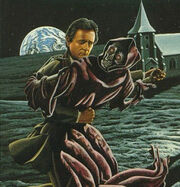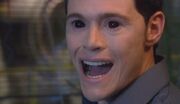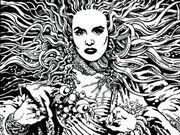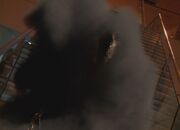- You may wish to consult
Death (disambiguation)for other, similarly-named pages.
Death was an Eternal and a Menti Celesti, one of the goddesses of Gallifrey, embodying death itself.
Death sometimes took on both male and female forms; as one of the Menti Celesti Death was a female goddess, which was also the gender it presented as in her dealings with the Seventh Doctor. However, some Earth myths depicted Death as male. When faced with Death, Torchwood Three ended up primarily referring to the entity as an "it".
According to Suzie Costello, when one died and entered the afterlife, Death would stalk them in the darkness. (TV: They Keep Killing Suzie)
Biography[]
Origins[]
Death was younger than her sister Pain but older than Time. (PROSE: Set Piece)
According to a Gallifreyan fairy tale, Death was born while the gods were drunk, and they accidentally gave her name to someone else. Since nobody remembered her name or who it had been given to, Death lamented, "Everything and everyone has a name, except for me." As a result, Death began to take away the names of mortal beings. (PROSE: Return of the Living Dad) She herself once claimed that her kind were "the dreams of Time Lords", and that they "leak out across the universe", only occasionally being given physical form by entities such as the Timewyrm. (PROSE: Human Nature)
Unbeknownst to most, the particular incarnation of Death known to the Seventh Doctor came into being as the child of Jasmine Surprise Hutchings and Ricky McIlveen, in a union foreseen and planned by Jasmine Surprise's mother Ishtar, who was the Timewyrm herself. (PROSE: Happy Endings)
Influence on Gallifrey[]
During the Old Time on Gallifrey, Death sent a messenger to Slothe. The Messenger killed the inhabitants of Slothe, until one day Presus rose up and fought the creature, killing it. (PROSE: Blind Fury)
During the Doctor's youth, he killed Torvic. Rather than becoming Death's Champion, the Doctor made a deal with Death so she would choose another Time Lord, later known as the Master. The Doctor would later forget about this encounter, (AUDIO: Master) although he remembered seeing Death on a Gallifreyan hillside. (PROSE: Set Piece)
Activities on Earth[]
Torchwood Three discovered that in 1479, after a priest in the parish that would become Cardiff had used a resurrection gauntlet to save a girl named Faith from the plague, Death began manifesting in the world of the living. It needed to reap the souls of thirteen dying people to permanently anchor itself to the physical world. Death killed twelve people, but Faith managed to stop it before it could collect a thirteenth victim, which would have enabled it to enter the universe permanently. (TV: Dead Man Walking)
However, a fairy tale related by the Brothers Grimm gave an account of more benevolent dealings between Death (depicted in the tale as male) and humanity. The story, entitled Godfather Death, told of a man who could not afford to keep his thirteenth child and gave them to Death to raise. Death raised the child to become a physician before the child defied him to save the life of a princess. Furious, Death brought the child to a cave where everyone's life was represented by a candle, marking a short one as the child's and ending their life. (PROSE: The Knight, The Fool and The Dead)
Dealings with the Seventh Doctor[]

Death dancing with the Doctor on the Moon. (PROSE: Timewyrm: Revelation)
The Seventh Doctor met Death for the first time on the Moon, when she was summoned by the Timewyrm as a robed skeleton. (PROSE: Timewyrm: Revelation)
Death briefly spoke to the Travellers in Puterspace stating that three quarters of them would die, but would not state which of them. (PROSE: Love and War) The Doctor made another deal with Death to save Ace and offered himself in her place. (PROSE: Love and War) Death later took the life of Doctor John Smith. (PROSE: Human Nature)
On several occasions, the Doctor said he was "friends" with Death. (AUDIO: The Death Collectors, Spider's Shadow) He once won a bet with Death. (PROSE: SLEEPY)
Death picked Mortimus to be her champion as a means of revenge upon the Doctor. Mortimus did not fully grasp the cosmic significance of the deal he had bartered. (PROSE: No Future)
When the Doctor suffered a one-sided heart attack at Roz Forrester's funeral, he had a vision of Death taunting him about taking the life of one of his companions, and that some day soon, she will take him, when he is alone and friendless, without warning and without meaning. (PROSE: So Vile a Sin)
Death, along with Time and Pain, attended Bernice Summerfield and Jason Kane's wedding in Cheldon Bonniface on 24 April 2010. (PROSE: Happy Endings)
At some point, the Doctor made a deal with Death to give the Master a new start in life as a good and honest man for ten years, feeling guilty for how he turned out. However, after the ten years, it was agreed he would have to kill the Master.
When the ten years expired, Death sent the Doctor to Perfugium, where "John Smith" was living. Taking on the identity of John Smith's maid, Jade, Death tormented the Doctor, John Smith and his friends. This led to one of his friends, Victor Schaeffer, killing his own wife, and John's love, Jacqueline. When the Doctor couldn't go through with killing John, he realised his significance in creating the Master, and how he had turned him into Death's Champion, by making his original deal with Death.
He constructed a new deal with Death, so that he wouldn't have to kill John, but would instead have to kill an innocent person in the place of an assassin (who was just a disguise of Death again), but couldn't go through with that deal either. Death also made a deal with John Smith that to remain as John Smith, he had to decide whether he would make the Doctor Death's Champion, or if he would kill Victor so that Jacqueline would be reborn, but become the Master again. It is still unknown what his decision was. (AUDIO: Master)
Death stalked the Seventh Doctor for some time. The Doctor ended up making a deal with Death so that he could save the life of a tramp, unaware that his death would have had repercussions in the Web of Time. (PROSE: The Tramp's Story)
At one point, Death took the name "LaMort" and moved to Sydney in the 19th century, interested in the novelty of colonial Australia. Two hundred years later, she had become bored with all the ways and places that death took place. She intended to commit suicide by overdosing on pills. However, the Doctor, Benny, and Ace visited her, and the Doctor made Benny describe all the planets that humans had brought death to in her time. With the promise of all these new virgin worlds, Death resolved not to commit suicide, and she dropped her pills; they transformed into souls and melted away. (PROSE: Virgin Lands)
Later activities[]
In a junkyard on Ha'olam, a black Persian cat and two other strays attacked Sam Jones' cat, who was Life, for invading their territory. (PROSE: Seeing I)
Though Death's sisters Life, Time, and Fate fled the Spiral Politic at first foresight of the War in Heaven, Death stayed behind and watched them leave. (PROSE: Hark! The Herald Angels Sing) In the post-War universe, Sabbath followed the Eighth Doctor on a trip into Death's abode. Despite her history with the Doctor prior to the War, she did not recognise him. (PROSE: Camera Obscura)
Encounter with Torchwood[]

Death possesses Owen. (TV: Dead Man Walking)
When Owen Harper was resurrected with the same gauntlet, Death used him as a gateway into the universe, and possessed him repeatedly. While doing so, it repeated "I shall walk the earth and my hunger will know no bounds" in a strange language.
Eventually, the energy from Death that was keeping Owen animate fully transformed Owen's cell structure, allowing Death to cross through into the universe. It briefly possessed Owen again before escaping his body as a thin gray vapour, and then began to materialise in the form of a ghostly skeleton shrouded in smoke, growing more and more solid the stronger its link to the universe became. It travelled to St Helen's Hospital and began killing and collecting the souls of the staff and patients that Torchwood failed to evacuate from the hospital in time.
Death claimed twelve of the thirteen souls it needed to fully enter the universe, but before it could claim a thirteenth victim, Owen trapped himself in one of the rooms of the hospital with Death. Death realised too late that as Owen was already dead, it could do nothing to him and could not use him to fuel itself. With Owen literally fighting Death to keep it busy until its time ran out, it ultimately ran out of energy and its physical form dissipated as it returned to the Afterlife. (TV: Dead Man Walking)
Legacy[]
A version of Death appeared in "the Sandman comics", with which Sam Jones was familiar. At a goth bar in San Francisco, Sam and the Eighth Doctor noticed that the bartender was dressed as this version of Death. (PROSE: Vampire Science)
Appearance[]

Death's appearance as one of the Menti Celesti. (PROSE: Prelude Love and War)
As an intelligent concept, Death was only occasionally given physical forms. Her avatars included a black Persian cat, (PROSE: Seeing I) a hooded skeleton, (PROSE: Timewyrm: Revelation) whose image was known in Earth's culture as the Grim Reaper, (TV: Dead Man Walking, The Visitation) a beautiful woman with flowing fair hair, (PROSE: Prelude Love and War) and "a girl, about fourteen, dressed in black, with dark hair cascading down her pale features". (PROSE: Happy Endings) After manifesting in the universe through Owen, Death had the physical form of a human skeleton shrouded in grey vapour. (TV: Dead Man Walking)
Abilities[]

Death's unfinished physical form created from the energy drawn from the deaths of twelve mortals. (TV: Dead Man Walking)
When gaining a physical form in the world of the living, Death had the ability to bring forward the death of any mortal. It favoured the dying or nearly dead, but could do the same to healthy individuals if necessary — although it could not permanently kill the immortal Jack Harkness, and had no power over undead beings like Owen. With a touch, Death could also sap away a mortal's life as he did to Martha Jones, bringing them to extreme old age without actually killing them; however, this effect would reverse itself once Death ceased manifesting in the mortal plane. (TV: Dead Man Walking)
References[]
At some point, "someone" sent what Doom, the self-proclaimed "universe's greatest assassin", believed to be "literal Death" after her. Doom found herself circled by a mysterious shadow wherever she went, and believed that she would only be able to evade the entity for twenty-four hours unless she could find the Doctor first. (WC: Meet Doom - the Universe's Greatest Assassin!) However, the First Doctor revealed the figure was not actually Death, but simply a Gatherer interested in consuming the paradox at play. (PROSE: Out of Time)
Behind the scenes[]
In Happy Endings[]
The Eternals Death, Time, and Pain explicitly attend Bernice Summerfield and Jason Kane's wedding in Happy Endings. Death is described as wearing a cape.
Later in the novel, Bernice talks with an unnamed teenage girl who has similarities to Death as depicted in Neil Gaiman's The Sandman comics. The teenage girl has pale features, dark hair, and is dressed in black. She also says it will be her job "to turn off the lights once everybody's gone". Death makes a similar statement in Gaiman's The Books of Magic #4.
Gaiman's Death was depicted as one of "the Endless," a line-up of cosmic embodiments of concepts. Gaiman's Endless, who debuted in 1989, had notable similarity to the Menti Celesti, down to the words "Endless" and "Eternal" being synonymous, thus facilitating the identification. The original run of Sandman comics was almost exactly contemporary with the Virgin New Adventures, making the crossover allusion doubly significant. However, the canonical line-up of siblings in The Sandman differs from the one used in DWU media: there is no Endless of Time, a male Destiny instead of the female Fate, and a male Destruction instead of Pain. Additionally, Destiny is described as the oldest of the Endless, whereas Pain is the oldest of the Menti Celesti.
Although according to Paul Scoones, Paul Cornell himself confirmed the allusion to The Sandman in Death's description in Happy Endings[1] Neil Penswick (to whom the section of Happy Endings in which she appears is attributed) disputed this notion in the fanzine Broadsword. Though acknowledging that she "had appeared in other works", he denied that this was in fact Gaiman's Death.[2]
In Torchwood[]
The untranslated form of Death's dialogue in TV: Dead Man Walking ("Melenkurion abatha duroc minas mill khabaal!"/"I shall walk the Earth, and my hunger will know no bounds!") is a quotation from Stephen R. Donaldson's dark fantasy series The Chronicles of Thomas Covenant. Within the series's setting, the Land, it is part of a powerful incantation known as the Seven Words. "Melenkurion" means bastion or source; "abatha" means endurance, or the need for it; "duroc" means Earthpower, a type of natural energy found within the Land; "minas" also means Earthpower, but used as a foundation rather than as theurgy; and "khabaal" has numerous meanings. The sixth word, "harad", which signifies a commitment not to use Earthpower for dark purposes, is omitted here; it had not been revealed until the then-recent eighth volume, so it is unclear whether its omission from the episode is significant or intentional. When a fan described the scene to Donaldson, he replied that he had never heard of Torchwood, but that "if it isn't a) an "homage" or b) an in-joke, then it's just stupid. I suggest that we all simply enjoy it for whatever we think it is. Unless the makers of "Torchwood" know something I don't? <muffled gasp>"[3] However, Donaldson was impressed when an anonymous fan subsequently told him that Davies was a huge fan of the Covenant books and re-read them once a year.[4]
| ||||||||
